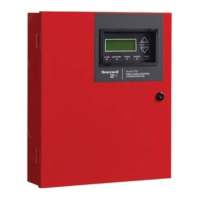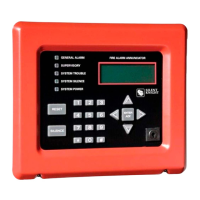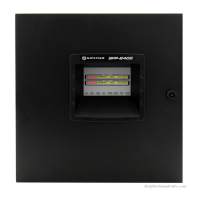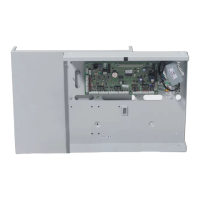6700 Manual — P/N LS10148-001SK-E:F 8/29/2022 81
Point Programming
8.5.2 Point Programming for the Internal or External Power Module
To program for an internal or external power module points, follow these steps:
1. Login to the panel.
2. Select 7 to access the Program Menu.
3. Press 4 to enter the Point Menu.
4. Press the up or down arrows to select the desired module. Press ENTER. Refer to Section 7.5 for the available choices.
5. Enter the number of the circuit or point you want to edit. Refer to the table below for available selections.
6. Press ENTER.
7. To select the Type, press the up or down arrows, then, press ENTER.
8. To select the Function, press the up or down arrows, then, press ENTER.
9. To select the Group, press the up or down arrows, then, press ENTER.
10. To edit the Point Name, press the right arrow to skip Point Name Edit. See Section 8.5.
11. Repeat steps 1 through 10 for all circuits.
SWITCH
ZN_AUX1 Latching Use these switch types if you want to monitor special zone-level conditions.
Non Latching
ZN_AUX2 Latching
Non Latching
SYS_AUX1 Latching Use these switch types if you want to monitor special system-wide conditions.
Non Latching
SYS_AUX2 Latching
Non Latching
DETECT SW Used to monitor conventional 4-wire detectors, a contact closure will generate a detector
alarm event.
TAMPER Latching Performs identically to a supervisory switch, but will be indicated as a tamper switch on the
LCD annunciator.
Non Latching
MAN REL Manual release switch, typically a pull station.
ILOCK Interlock release switch input.
CO DETECT SW CO Detector Switch
CO SUPERVISORY
DETECT SW
CO Supervisory Detector Switch
STATUS PT Status Point Switch
TROUBLE_MON Use this switch type to monitor trouble from external devices. Trouble monitors are used in
HVAC operations.
NOTIF
OUTPUT PT Select Group Output Point, a general use notification type. Use for driving standard notification
appliances.
AUX CONST Use constant power for applications that require a constant auxiliary power source. Power
is always present at Constant circuits.
AUX RESET Use for auxiliary power, resettable applications. See “Resettable Power” on page 48 to
learn how this option operates.
AUX DOOR Use for auxiliary power, door holder applications. For example, if you were using an
auxiliary power supply for door holders, you would use this option. See “Door Holder
Power” on page 47 to learn how this option operates.
RELAY
OUTPUT PT Select Group Output Point, a general use relay type. Use for applications requiring a relay, such as
elevator recall.
AUX RESET Use for auxiliary power, resettable applications. See “Resettable Power” on page 48 to
learn how this option operates.
AUX DOOR Use for auxiliary power, door holder applications. For example, if you were using an
auxiliary power supply for door holders, you would use this option. See “Door Holder
Power” on page 47 for a description of how this option operates.
W-Gateway Wireless Gateway
W-SWITCH Same as SWITCH
W-Relay Same as Relay
Type
Selection
Function
Latching
Option
Comments
Table 8.3 Point Programming for Internal SLC Module (Continued)

